Computed tomography having motion compensation
a computed tomography and motion compensation technology, applied in the field of computed tomography having motion compensation, can solve the problems of non-rigid movement and preventing consistent image reconstruction, and achieve the effect of low deformation, effective compensation and iterative optimization convergent particularly quickly
- Summary
- Abstract
- Description
- Claims
- Application Information
AI Technical Summary
Benefits of technology
Problems solved by technology
Method used
Image
Examples
Embodiment Construction
[0048]The exemplary embodiments explained below are preferred embodiments. In the exemplary embodiments, however, the described components of the embodiments in each case represent individual features that should be regarded independently of one another, and which in each case also further develop the invention independently from one another and thus should be considered, even individually or in another combination than the one shown, as being a constituent part of the invention. Furthermore, the described embodiments can also be supplemented by further ones of the already described features.
[0049]FIG. 1 shows a tomography system 10, which can be for example an X-ray C-arm system. The tomography system 10 can include a sensor device 12, a projection device 14 and an image generation device 16.
[0050]The sensor device 12 can include a detector having a plurality of radiation sensors 18, of which only some have reference signs in FIG. 1 for the sake of clarity. Sensor entry surfaces 20...
PUM
 Login to View More
Login to View More Abstract
Description
Claims
Application Information
 Login to View More
Login to View More - R&D
- Intellectual Property
- Life Sciences
- Materials
- Tech Scout
- Unparalleled Data Quality
- Higher Quality Content
- 60% Fewer Hallucinations
Browse by: Latest US Patents, China's latest patents, Technical Efficacy Thesaurus, Application Domain, Technology Topic, Popular Technical Reports.
© 2025 PatSnap. All rights reserved.Legal|Privacy policy|Modern Slavery Act Transparency Statement|Sitemap|About US| Contact US: help@patsnap.com



